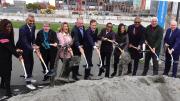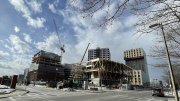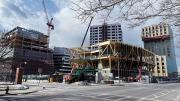On November 1, the Harvard Allston Land Company (HALC) and development partner Tishman Speyer hosted a groundbreaking ceremony in Boston’s Allston neighborhood to mark the beginning of construction on the enterprise research campus (ERC). The event, attended by Harvard President Claudine Gay, former president Lawrence S. Bacow, Boston Mayor Michelle Wu ’07, J.D. ’12, Massachusetts House of Representatives majority leader Michael J. Moran, Tishman Speyer CEO Rob Speyer ’91, and numerous other elected and appointed officials, celebrated the collaboration among Harvard, its development partner, the City of Boston, and the local community and its representatives that enabled the project to proceed. Progress had been slowed by negotiations over issues such as the quantity of housing that would be designated affordable in this first phase of construction, which will consist of 900,000 square feet of commercial development on six acres of Harvard-owned land, including lab space for life sciences companies, 343 rental apartments (a quarter will be affordable), a 246-room hotel, street-level shops and restaurants, and more than 2 acres of public outdoor space. Parallel construction of an adjacent University-owned and operated conference center will also be managed by Tishman Speyer. The site, facing Western Avenue, is across from the Business School campus.
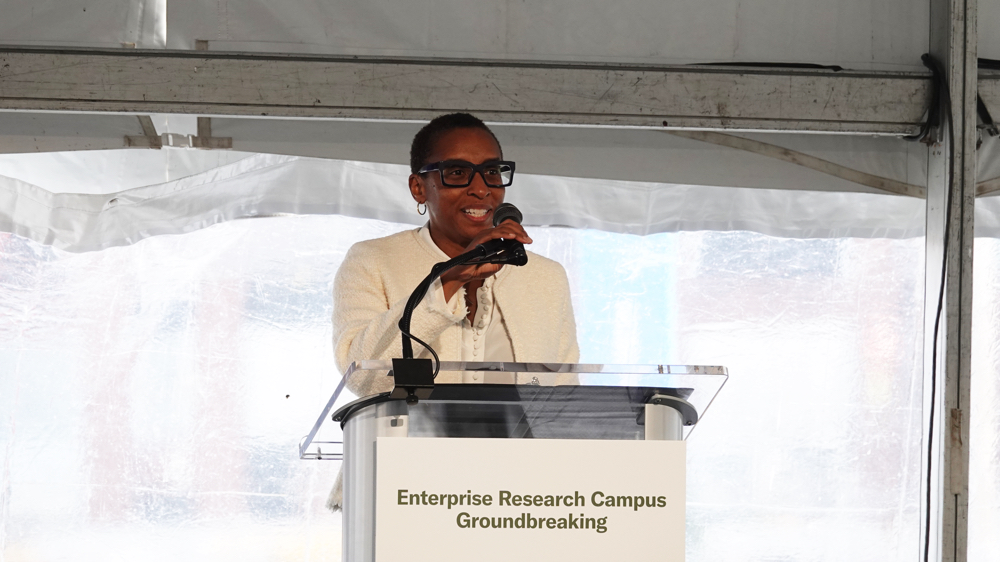
Under a tent that kept the day’s chill winds largely at bay, HALC CEO Carl Rodrigues introduced the speakers, beginning with Gay. “For as long as I can remember,” she said, “I have driven, biked, run and walked” down Western Avenue in Allston, the site of the ERC, “with a sense of hope…now joined with a tremendous sense of responsibility.” Expressing gratitude for the University’s relationships with the City of Boston and the residents of the Allston-Brighton neighborhood, she noted Harvard’s partnerships to support the arts, education, and housing affordability programs in Allston spanning the past decade and a half and the encouraging signs of an emerging campus. “We are fueled by some shared principles,” she said: “Harnessing creativity and invention for the benefit of the world; ensuring that opportunity is widespread; and, importantly, celebrating Allston as a place for all. Each element of the ERC,” she continued, “is the result of deep engagement with the City of Boston and this neighborhood. The open spaces, the affordable housing, the workforce opportunities that will go on to define this community will lay the foundation for a thriving future of the city of Boston.”
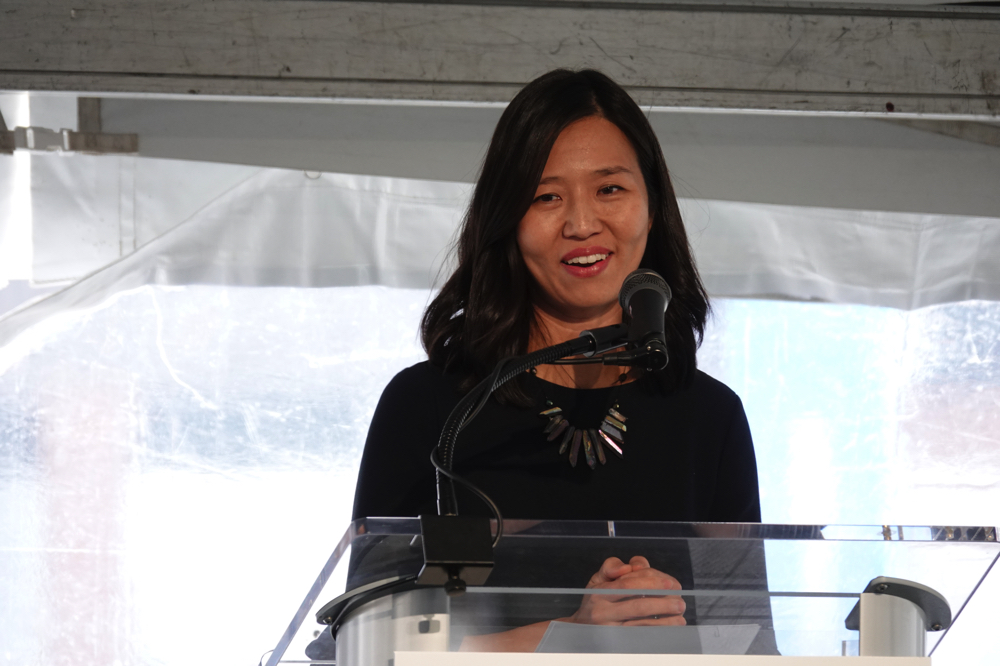
Mayor Wu, for whom Boston’s stratospheric rents and low vacancy rates have been of critical concern, noted that the fact that 25 percent of the apartments in the first phase of the project will be affordable and income-restricted is a “record for the highest percentage ever for a market project in Boston,” and one that will directly increase the affordable housing supply in the Allston-Brighton neighborhood. She also thanked Harvard for donating nearby land at 65 Seattle St. to enable affordable homeownership opportunities, for donating $25 million to fund a neighborhood affordable housing program, and for agreeing to make ice-time available to a local youth hockey program. “Nothing was left on the table in coming together across two very important institutions to maximize the benefit to our communities,” she said. “This project is proof of, but also a blueprint for, our ability to ensure that the benefits of Boston’s growth are shared by everyone.”
Wu added that although she was at the groundbreaking in her official capacity, this was also a personal moment for her, because she “owes so much of my life and the opportunities that I’ve had to Harvard.” She recalled her tears after her family (immigrants from Taiwan) dropped her off at campus and watching as they drove away, returning to Chicago. And she thanked, in particular, Glimp professor of economics Edward Glaeser, an expert in urban growth with whom she studied economics as an undergraduate, and who is now helping advise her administration “on the very policies that we need to help our economy recover.”
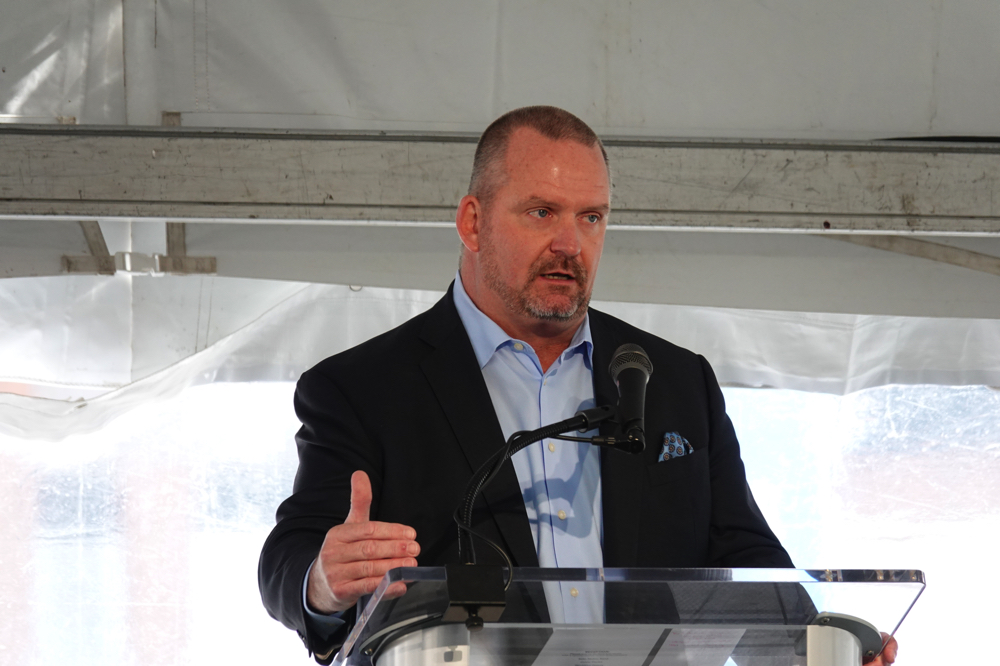
State majority leader Moran, noting that the occasion marked the first time in his 18 years of elected service that he had been invited to speak at a groundbreaking like this one, attributed his inclusion to Wu, to Harvard’s leadership, and to the fact that the Allston community had fought hard for its interests. “We want development,” he said, adding that “We want it to be responsible” and part of “a shared process” to ensure that “our voices are seriously considered.”
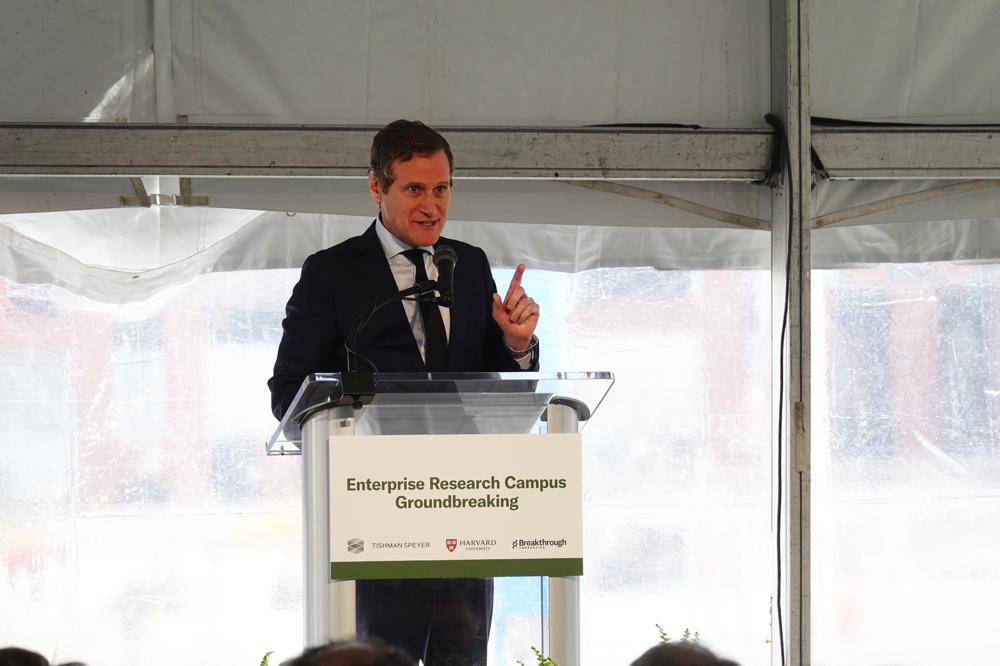
Tishman Speyer CEO Rob Speyer emphasized that the ERC would be inclusive: “This will be a place where everyone is welcome”. He noted that the project includes “the largest inclusionary investment in any private project in the history of the city of Boston,” and thanked Harvard for “inspiring us to connect to a [diversity, equity, and inclusion] fundraise that surpassed all of our expectations.”
As trucks rumbled by outside, and huge stationary cranes swung their payloads into position, Speyer continued, “Together, we’re going to create the next great hub for life sciences. Because we share a belief that by providing cutting-edge space to bring Harvard researchers and great entrepreneurs together, we might actually help change the world”—although he did not name any anchor tenants for the new space. He thanked Mayor Wu and other officials for “being true partners, as we reached an historic agreement to bring greater affordability to this growing neighborhood.”
Additional remarks by local officials were followed by a ceremonial groundbreaking outside the tent, and a reception featuring foods from local Allston businesses. Construction is expected to continue into 2026.
